History is filled with unique characters and unique groups of people, many of whom we can learn things from. Each of these groups had to find a way to survive the hardships of life, often times overcoming great obstacles along the way. Others became great obstacles to their neighbors, either through fighting wars with them or from stealing their resources.
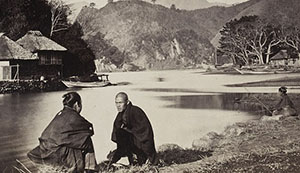 One of the most unique groups in history are the Japanese Ninja. These were probably the world’s first “snake eaters,” although I doubt that snake was on their diet. Rather, I’m using this term as it is used in the military, in reference to all types of commando units.
One of the most unique groups in history are the Japanese Ninja. These were probably the world’s first “snake eaters,” although I doubt that snake was on their diet. Rather, I’m using this term as it is used in the military, in reference to all types of commando units.
Today’s many special operators all trace their roots back to the British SAS (Special Air Service), a clandestine special forces or commando unit of the British Army, formed at the beginning of World War II. Like the SAS, the ninja had to develop their own methods, equipment and even weapons, as there was nobody for them to copy from. Looking at it from this side of history, we can see that they excelled in this most necessary military art.
Ninjas may have been great clandestine warriors, but they were also great inventors. Pretty much everything they used was unique to their clan. While they were experts in the use of the Samurai’s Katana sword and the bow, they were also experts in a wide variety of other weapons that the Samurai didn’t use.
Their history of invention didn’t end there. Ninjas were interested in many areas, such as herbal medicine. Their studies in this area led them to create their own survival food, which they would use when on their missions. These included foods like hyourougan, kikatsugan and suikatsugan. Of the three, suikatsugan supposedly had some amazing properties, such as allowing the ninja the ability to go without water.
Suikatsugan supposedly restrained the thirst of the ninja, allowing them to go as much as 45 days without water, if they ate just three of these small superfoods. That’s probably an exaggeration, as we can normally go a maximum of three days without water. Even with the highly disciplined lifestyle they lived and the rigors they normally put their bodies through, going 45 days would be too much of a stretch. However, siukatsugan does cause one to salivate, giving the appearance that one could go without water.
Related: 30 Lost Ways of Survival from 1880 We Should All Learn
While this superfood may not actually do what the ancient writings postulate, we can be sure that it was a compact, healthy source of nutrition. While on a mission, ninja needed to save every ounce of weight they could. Their day-to-day life was rigorous, so as to train their bodies for the rigors of the missions they undertook. Foods like this were not eaten carelessly, but rather, developed with care over a considerable amount of time.
Preparing the Ingredients
My curiosity being aroused, I went about to make my own ninja superfood. The first challenge was in finding the ingredients, as they are not things that I commonly buy at my local supermarket.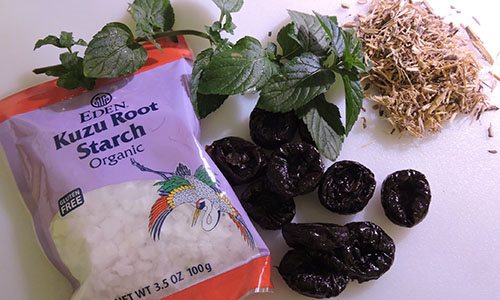 All of the ingredients needed to be ground up and mixed together, forming something roughly the consistency of cookie batter, albeit a lumpy cookie batter. In the interest of maintaining something of the origins of this food, I chose to grind the ingredients with a Mexican mortar and pestle, called a “molcajete.” These are usually made of porous volcanic rock, but I have one that is made of granite. While not polished like a Japanese one would be, it is a fair approximation.
All of the ingredients needed to be ground up and mixed together, forming something roughly the consistency of cookie batter, albeit a lumpy cookie batter. In the interest of maintaining something of the origins of this food, I chose to grind the ingredients with a Mexican mortar and pestle, called a “molcajete.” These are usually made of porous volcanic rock, but I have one that is made of granite. While not polished like a Japanese one would be, it is a fair approximation.
You could probably accomplish the same thing using a blender or food processor; but would lose the feeling of “originality” in doing so. In exchange, you would save a considerable amount of time, which would make the process more enjoyable.
Licorice Root
Licorice root is good for a variety of stomach ailments, including ulcers, heartburn and ongoing inflammation of the stomach lining. I had to purchase mine online, as I was unable to find it locally. It came shredded in a bag. While the root does not naturally taste much like licorice when eaten alone, it did add a distinct licorice flavor to the mixture. 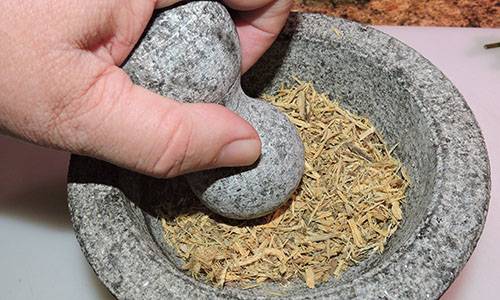 It was difficult to grind up the already shredded licorice root with the mortar and pestle; probably even more so because the licorice root was already shredded. I suppose it could have been left in the shredded form, but that might have been difficult to chew and even digest. I was able to grind it considerably smaller, but it took a lot of work to do so.
It was difficult to grind up the already shredded licorice root with the mortar and pestle; probably even more so because the licorice root was already shredded. I suppose it could have been left in the shredded form, but that might have been difficult to chew and even digest. I was able to grind it considerably smaller, but it took a lot of work to do so.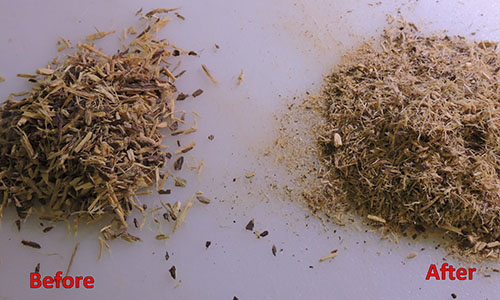
Kudzu Starch
Kudzu or Kuzu starch is a common ingredient in Japanese recipes, used predominantly for thickening sauces. It provides a bright, translucent quality, without adding a starchy flavor. However, being a starch, it is a good source of carbohydrates, which the body quickly turns into sugar for energy. Kuzu starch is an anti-inflammatory, which is also good for treating stomach disorders.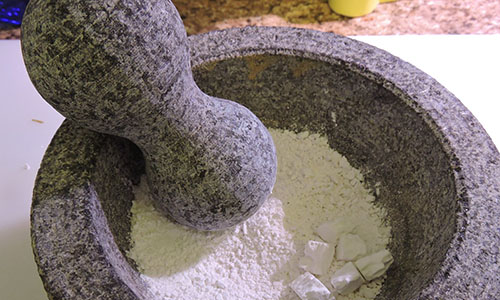 I ended up buying this ingredient online as well. The starch comes in chunks, such as those shown to the right in the mortar above. These are easily crushed to powder, making them the easiest ingredient in the recipe to work with. Once mixed with the other ingredients, this one dissolves and probably works as a binder to hold everything together.
I ended up buying this ingredient online as well. The starch comes in chunks, such as those shown to the right in the mortar above. These are easily crushed to powder, making them the easiest ingredient in the recipe to work with. Once mixed with the other ingredients, this one dissolves and probably works as a binder to hold everything together.
Dried Plums
Dried plums are a great source of nutrition, carrying a wide variety of vitamins and minerals, as well as fiber and antioxidants. If you have trouble finding these in your local grocery store, look for prunes, as for some reason, dried plums are commonly known by this name. Prunes are common, making them the easiest ingredient to come up with. This ingredient probably provided most of the nutritional value of the suikatsugan, including a fair number of calories.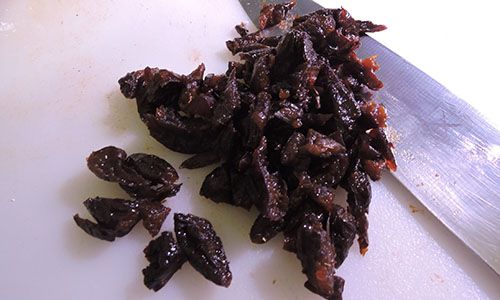 Before grinding the dried plums, dice them with a knife. This will cut up the skin, helping ensure that when you grind them, they don’t stick together in large lumps. I ended up adding more after my first grind and got a bit lazy dicing and grinding them. That made my mixture lumpy and forced me to go back and mash it again.
Before grinding the dried plums, dice them with a knife. This will cut up the skin, helping ensure that when you grind them, they don’t stick together in large lumps. I ended up adding more after my first grind and got a bit lazy dicing and grinding them. That made my mixture lumpy and forced me to go back and mash it again.
Since the finished suikatsugan is supposed to be rolled in small balls, we want to mash this as well in the mortar and pestle. While it would theoretically be possible to use it diced, you would need to roll the finished product into larger balls.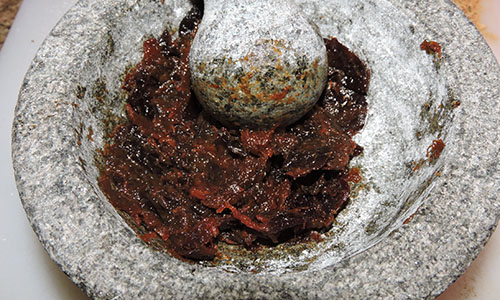
Mint Leaves
Japanese mint is all but impossible to locate here in the United States. About the only thing you can do is to buy the plants online; but even then it is hard to find. Fortunately, according to an old botanist I ran across, Japanese mint is almost identical to Spearmint, which is relatively easy to find. I was able to buy spearmint in the garden section of my local home improvement center.
Related: 8 Medicinal Plants You Can Grow Indoors
It is the mint that provides the majority of the health benefits of the suikatsugan, as well as being the ingredient that helped the ninja deal with thirst. Japanese mint is used for the treatment of digestive problems, fever, pain, spasms, headaches, toothaches, cramps, earache and a host of more serious medical problems. Based upon the information I have been able to find online, as well as that which I could find for spearmint, one is a reasonable substitute for the other.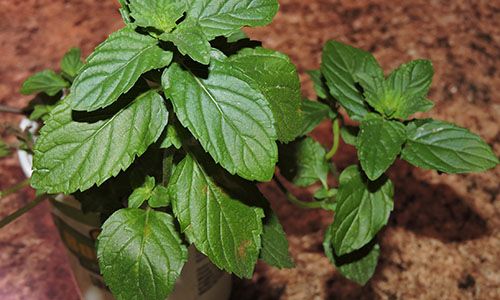 Grinding the spearmint leaves in the mortar and pestle is all but impossible, unless you are going to make a lot of suikatsugan at one time. Instead, you can chop it fine on a cutting board, just as you would do preparing other herbs for cooking.
Grinding the spearmint leaves in the mortar and pestle is all but impossible, unless you are going to make a lot of suikatsugan at one time. Instead, you can chop it fine on a cutting board, just as you would do preparing other herbs for cooking.
Making the Suikatsugan
Once the ingredients are prepared, making the suikatsugan requires nothing more than mixing them up. I first tried mixing them with a spoon, which was a joke. The plum paste stuck to the spoon and everything else stuck to it. Nothing got mixed. I ended up mixing it with my fingers, which is probably the way it was originally done. Not only is this a very efficient way to mix everything together, but you’ve got to get your fingers into it to make the balls anyway.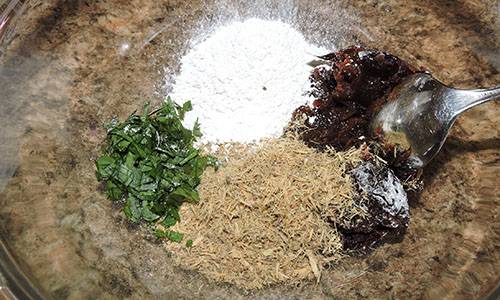
The ratio of ingredients should be something like:
- 1 part chopped Japanese Mint leaves (or Spearmint leaves)
- 3 parts ground Kudzu Starch
- 5 parts ground Licorice Root
- 10 parts Plum paste
A small amount of water might need to be added, in order to help the dry ingredients (licorice root and kudzu starch) mix in. Don’t use too much water, as it will make the mixture too soggy and hard to work with. I used about a thimbleful and that was almost too much.
The finished mixture should be rolled into balls about 1 cm in diameter and put out to air dry.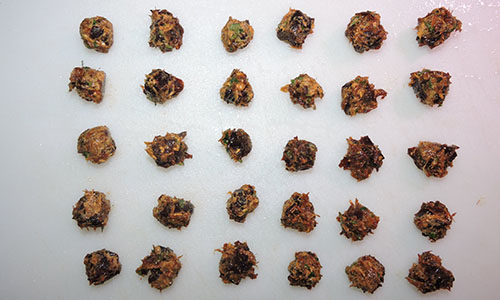
Taste Testing
After going through all this work, making the suikatsugan, I couldn’t just drop it with making the balls and taking a picture of them. I knew you would be curious about their taste and honestly, I was curious myself. So I tried it. I was prepared for a bad taste… but in the interest of science and all that…
It was surprisingly good. I could easily detect the different flavors of the mint and licorice root, as well as the dried plum which formed the foundation. While an unusual combination of flavors, they actually went well together. I was pleasantly surprised.
Even so, I’m sorry, I’m not going to try going 45 days without water, not even after eating three of them, which was supposed to be enough to keep a ninja from needing water. I can see how they would give the illusion of not needing water, as the strong flavors of mint and licorice do make one salivate. So, if you were in a place where you didn’t have enough water, I can see where eating suikatsugan would alleviate your thirst, at least for a short period of time. But you’re still going to need water once that feeling goes away.
On the other hand, suikatsugan should be a good survival food. Not only does it provide a good punch of energy; but it also has a great mixture of nutrients. The medicinal qualities of the various ingredients would probably help your body deal with the lack of food or lack of a balanced diet. So I can definitely see where it would be beneficial as something to pack along, either in your bug out bag, or as part of your survival stockpile.
Maybe trained ninja could go longer without water than you or I; I wouldn’t doubt it. But then, they expected to either die performing their mission or commit suicide after a successful completion of it. So I doubt that the full 45 days has ever been truly tested; they were probably gone before reaching that point.
You may also like:
50 Tips From the Great Depression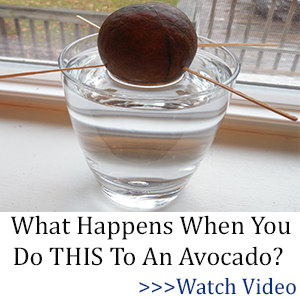
World’s Smallest Battery Powers House For 2 Days (Video)
Ingenious Foods People Made During Famines

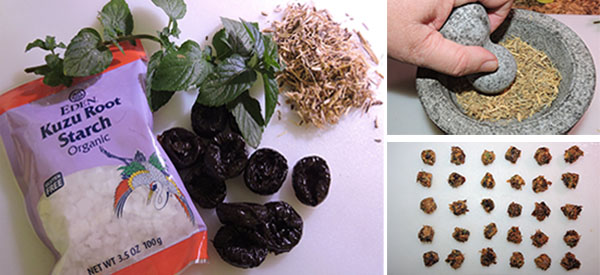













Too bad the traditional Japanese warrior was against using modern firearms and weaponry when it came available. Such as rifles with far reaching ammunition and could have stayed off a lot of walking and the need for as much nutrients. Which makes me think of the new California law that went into effect midnight west coast time that every single ammo purchase requires a back ground check. Puts a new spin on gun registration and restrictions. And it will cost a dollar per background check. So out of the over 13 million gun owners in california( of which their names and guns are in a state database) each ammo purchase is now in that database. And the sad thing is supposedly 63 percent of Californians voted for this. So it can potentially take in tens of millions per year for the state government to piss away. Just another tax. Anyway, ninjas can use firearms too. Any Californians on this feed have any info on what they see and hear about this?? I heard several reports about people buying up much of the am on shelves in the last couple weeks. Did anyone start stocking up on ammo back in 2016 after it passed? Does California restrict the amount of ammo you can have?
Come to Arizona, which a lot of Californians are doing, to make your purchases.
Red: You should not be happy with Californicans moving to your state. Despite what they say, experience has shown they corrupt the states they move too. They are like a cancer spreading across the western U.S.
I’m not, trust me, but see nothing wrong with buying things here needed back in Kali. They started to move into Washington and Oregon when I was a kid, like Jersians moved into Penna. They destroyed local politics. Tucson went from a good burg to uber-liberal in the last 50 years. this area is very conservative. Now the dnc is making inroads thanks to the Kalis. Yeah, for a while I worked for an importer as guard. What he hauled from Florida was his business. It all went right to NYC and was dropped. then, load up on diesel in Jersey, 200 gals. Tanks in the back, 200 gas. Haul to Penna and sell that, then back to Florida. Cases of cigarettes went to NYC, and then taken north to the Mohawks. that didn’t pan out too well after the old women came down on the kids taking smokes over the river, apple jack and corn to NYC, then head south again. It paid well, till he got stupid with all that cash flow. I got a job washing dishes and donno from nuthin when cops asked about him. Better dishpan hands than the trash he was dealing with.
now i may have only been on this earth for fifteen years,but despite that i’ve heard a great many things (and remembered most of them) and i dont see much in the way of californians being a “cancer” now hardcore leftists and anti gunners and liberals who take it too far,those people are certainly a cancer in every sense of the term, frankly its not the people per se, its the unnatural and impossible ideals people try so desperately to live by, such as violence never being the answer,violence if often the only option,now as for domestic matters yes i agree a couple should talk it out,but in terms of bullying and other problems of the like, the government is doing nothing but feeding the epidemics, by disallowing us youth to defend ourselves,and other things, in short the future is grim for all people,i’m only fifteen and i can see that for sure.
Young Prepper: you gave a rundown of the cancers afflicting Kali. Liberals have no ideals, only a bottomless greed to own and to control. Watch the Hunger Games, which werer about liberals taking control. niio
That describes libtards in general!
The law which was passed by a large majority of ninnies also prohibits importation of ammunition from outside the state. It is a felony which will result in the loss of being able to own a gun or ammunition, by state and federal law — or even gun parts for that matter.
Or course if I am already smuggling illegal, dope or whatever else is smuggled across the border, bringing ammunition is no big deal. The way sentencing law is in the PDRK, you probably wouldn’t get any more time for smuggling all three as just smuggling one.
As anyone might guess, this is really a hot button issue for me. I could run on for 10,000 words or more quite easily kvetching and complaining about the state of the PDRK’s political system — it certainly isn’t the state I decided I wanted to live in 60 years ago. At one time I was quite proud to claim I lived in the state with the best university system in the world, the best road system in the world, some of the most reasonably priced and feature loaded housing in the world and a reasonably decent K-12 school system. Unfortunately, today it is a single party, third world country.
With that I will wrench myself away from the keyboard – or at least stay on topic.
Chuck, concerning the import of ammo from another state, my God All Mighty it sounds like they are a country within themselves and might be putting check points at the border of other states. They are cutting off outside commerce. But if it was marijuana by all means no problem. That state is a lost cause. Move when you can
Red, I live in Texas. Our ammo supply is plentiful.
God bless Texas. Ammo is plentiful all over, but too many states make people grab ankle to buy some.
LCC, I agree with Wannabe. Get out before they start to raid good people again to keep the criminals safe. Phoenix area is good, if you know desert hills. It used to be a bad town, but since Uncle Joe was sheriff, it got pretty cool. Still a city, but not as bad as it was. niio
phoenix is an obscenely dangerous city, drugs and cartels are near everywhere,or so i heard on the show “drugs inc”
If you live up around Phoenix, you have my sympathy. From its founding, it always was a dangerous place. But, I’d rather get stuck there after dark than Tucson. I live much closer to Tsuk shon (dark, meaning spiritually) waters) and it doesn’t bother me. The town is several thousands of years old and far more deadly than the politicos lets us know. Meanwhile, neither can be a match against any city their size in Kali or the East coast. niio
Actually, Wannabe, that is not exactly correct. The Japanese took to firearms quite readily. If you read any accounts of battles from the time the Portuguese first were granted trading rights in the islands, firearms, matchlocks and cannon were used in every battle. The problem with the Japanese was that they isolated themselves from outside sources.. After the Portuguese were thrown out of the country due to the Jesuits fomenting rebellion against the regime, only the Dutch were allowed to trade and they were limited to Dejima Island in Nagasaki Bay. They were forbidden to travel. Japanese firearm technology stalled at matchlocks. It wasn’t until Perry arrived with percussion cap firearms that the Japanese realized the Westerners had a technological advantage over them in warfare. Huge efforts were made to obtain modern western firearms but there were two problems. First, western governments wanted to “open” Japan to trade, meaning to strip them of goods at low prices. No need to give the Japanese modern arms, that might make “opening” somewhat difficult. That meant that arms had to be smuggled into Japan limiting the quantity and jacking the price. Thus Japan in the mid 19th century had difficulty obtaining modern firearms.
The samurai looked down on firearms as not being worthy of their skill. It took a long time to learn to use a sword effectively or a bow. Spears and firearms were reserved for the ashigara or foot troops who were not samurai. It didn’t take a lot of training to teach a farmer how to thrust with a spear or to load and fire a matchlock. They were used as mass weapons with aiming being secondary. Samurai excelled in one on one combat but the battles were actually won by the ashigara who advanced with spears or stood off to the side and fired volley after volley of massed fire. Cannons were used for defensive purposes at castles or for offensive purposes against fortified positions much as they were used in medieval Europe. Cannons were generally too heavy and awkward to use for field offense or defense.
If you visit any arms museum in Japan, you will find a nice collection of exquisitely decorated and finely manufactured matchlock rifles. No pistols. The sword was for up close and personal offense or defense.
I have always been interested in the Japanese sword and Japanese history. It has been a favorite topic of mine since I first arrived in Japan in 1956.
Left coast, I just used it as a Segway to talk about ammo. Had to stay kind of on topic in order to spark conversation. Thanks for history lesson though. It is just that I wasn’t going for historical correctness.? I was thinking about the movie The Last Samurai where many traditional Japanese were against the change to modern weaponry. Cool movie, and it does have a scene with Ninjas in it. I winder if they were wngirged with this delicacy? Lol
The Last Samurai is based on actual 19th century Japanese history. A well-liked and respected leader from Kyushu tried to enforce his allegiance to the Tokugawa regime with conservative samurai against the peasant army of the Meiji emperor. The rebel samurai were armed mostly with swords and bows. The peasant army was armed with bayonet mounted rifles. You know which side carried the war.
Reinforces the old saying, “Don’t take a knife to a gun fight.”
Japanese army partially used the same kind of discarded tactics in WWII. A banzai charge with bayonet and sword worked against undisciplined Chinese conscripts with no military training. Didn’t work too well against machine guns, mortars and field artillery employed by disciplined, trained troops. Certain diehard officers still believed that cold steel and “Japanese Spirit” would overcome machine guns, etc. causing the extermination of their troops.
By the way, today starts all non-lead hunting of wildlife with firearms in the PDRK. Two-legged predators may still be taken with lead bullets. Interestingly enough if one is using an air rifle, one may still employ lead “pellets” although calling a .357, .45 or .50 caliber missile a “pellet” sort of boggles my mind. I haven’t determined whether we need permission of our masters in Sacramento to buy “pellets” or not and if there is any restriction on mail order pellets.
As far as I know, one may use crossbows and arrows and no restriction on purchasing of those items, nor of long bows and arrows.
Left coast , how do these new laws effect reloading supplies? Since they are only components and not a complete round, I would think there are no new restrictions to getting projectiles, powder, and the like. The laws are targeted to ammunition and not the individual components. Would be a great time for good citizens of California to get into reloading.
Just read an update, and it does not have any provisions concerning reloading components. That does not mean the jerk legislators won’t go after them in the future. Just another indicator that reloading is a great way to stay up on ammo.
No restrictions on crossbows + arrows YET. I’m sure they’ll get around to that. The limeys banned carrying knives.
iirc, the Ninja were very quick to take up firearms. I think I read that in a book by Masaaki Hatsumi.
I hope you realize that ninjas often posed as Gardners and ate regular meals. Get a history lesson.
Expert gardeners, in fact. IN those mountains they had to be. This is an emergency food, not for everyday use. I wouldn’t eat natural licorice every day, it thins the blood but is an energy food. niio
Yes, and licorice can raise blood pressure and lower potassium levels, so definitely not a daily food.
Actually Tokko, Ninja assumed many roles in medieval Japan. They were masters at disguise. They often were valued retainers who served their erstwhile masters while having an ulterior reason and assignment for treachery. They were the first CIA or NSA agents, if you will.
I have read a considerably number of books about Japan’s history, the ninja and the various eras of Japanese history as that history has always interested me. I spent four years in the Far East during my tour with Uncle Sam’s Misguided Children and have maintained my interest in Japan ever since. I currently subscribe to a local Japanese/English language newspaper and probably watch NHK more than I watch U.S. programs.
If one were to expound on the role of the Ninja in Japanese history, it could easily encompass a several hundred page volume.
Well, they restrict your water usage, your electricity; whats next? The amount of air you breathe? Na, they’ll just levy another tax
Interesting. I did wonder about a couple of things, both minor.
First was the use of regular dried plums rather than the Japanese plums. Not sure that there’s much difference, but just in case.
Second was the use of fresh spearmint. Since you were trying to grind it, I wondered if dried spearmint would’ve worked better since it could easily have been ground into a powder.
Otherwise, this sounds like an interesting thing to try. Of course, if you live in the southeastern US, you can probably get all the kudzu (kuzu) you want and then some since it grows rampantly there from some misguided government program decades back.
It isn’t mentioned how to best store these (temperature range ? in zip lock baggies ? paper bags ? storing in light or dark ?)…..or how long, stored properly, that they will remain edible ?
Bear in mind that the Ninja were extant in Japan from approximately the 12th or 13th century through the Tokugawa era which ran from the mid 16th century through the 19th century. During that time period anything that one carried was carried in some kind of cloth bag, usually cotton. If it were a highly important document, it would be carried wrapped in water resistant silk. No baggies, no temperature controlled storage units. If you are old enough to remember cookie and pie cooling trays that were stored in the window the Japanese pemmican might have been stored indoors in a ventilated box on ventilated shelves. Everything was made of paper, wood and cloth. Metal was expensive and generally not available to the lower classes except as tools. Japan is hot and humid in the summer. June is traditionally the rainy season in Japan, moving up from Kyushu to the northern island as summer progresses. May is the rainy season on Okinawa. Right now (first week of July 2019) Honshu is experiencing exceptionally heavy rains and flooding is predicted by the Japanese National Weather Bureau. So, if this was long term food, it didn’t need any special treatment. The most it would get, as I mentioned, was a ventilated box. As to how long it would last, probably depends on a couple of things, If it were able to be maintained relatively dry and how hungry you were. Also remember that in days of yore, moldy bread and cheese and slightly rancid meat were very commonly consumed. Read tales of sailing vessels in the 19th century and the complaints were often of brackish water, wormy flour and maggoty meat which was consumed nonetheless.
Also, many people died of the “bloody flux” which was severe diarrhea, probably salmonella, typhoid fever or some other disease entity whose chief symptom was raging diarrhea.
Alrighty then… Nice history & centuries old Japanese lifestyle lesson… But that’s 100% irrelevant to today, as far as how to STORE it (today) & how long it will remain edible. My question was actually meant for the author of the article… This is not something any of us will be prepared to just whip up the moment we experience an emergency situation for which we would need it. Therefore, its crucial to know how / where to store it TODAY, as well as how long we could expect it to remain viable. I hope the author will return to read our comments & questions—& will find out what I ask, if he doesn’t already know, and give me an actual answer, relative to today’s realities…
What I tried to point out and apparently you missed was that during the time period that this food was used, it was not stored in any special way, so other than keeping it from getting wet, no special handling is necessary. The Ninja would have carried these in a cloth bag either tied to his kimono sash or in the sleeve of his kimono. It it were raining, he or she would have carried them under their rice straw rain cape or wrapped them in treated silk to keep them dry.
As to how long they would last, that is a variable that probably even the author of this article can’t tell you. It would take hands on experience to be able to determine actual shelf life. As with most foods during that time period, they got eaten and if there were mold or worms, the mold got brushed off as did the worms or they got eaten along with the fruit balls. Food was scarce and people went hungry a lot of the time and weren’t quite as fastidious as we are today. No “Use by” dates then.
Thanks, but you should have said “it was not stored in any special way, so other than keeping it from getting wet, no special handling WAS necessary”… Yeah, you know your ancient Japanese history—but “what I tried to point out”….is that today is Still infinitely Different than back then. ..INCLUDING that when they DID make it back then, they did it PLANNING to use it—for specific Planned uses / purposes—in the very-near-to-immediate future. Likely not for anything they ever NEEDED to “store” it for for any real lengths of time… Like….Ever ! Not for purposes that required it to be made well in advance—as we most definitely WOULD today. Therefore, it’s Imperative that we Know what it REQUIRES for ‘long term’ storage, TODAY, in case an Unplanned, Unexpected surprise emergency cropped up… Can you just pull your head out of your book learning of the past, detach it Completely from that…& get it Fully into TODAY’s realities, as well as the needs WE would have—to make this stuff, possibly Very Far ahead of time for unforeseen times of crisis or emergency ? Again, your history lesson is completely useless to answer my questions regarding today—which mean making it WELL-PRIOR to anything that Cannot be planned for, for unforeseen use that could crop up at any time, very possibly in a quite distant time of need. Thank you again for your attempt to help with my valid questions, relative to Today & an entirely different set of circumstance than in centuries past—anywhere. As to mold, our digestive constitutions are not what they used to be—and some molds are toxic. Not to mention that there are likely many different types of mold here than there were / are in Japan. So mold ?? I’d rather do my best to Avoid them if at all possible, thank you. My questions Still stand, completely unanswered. Again, I hope the author will return to read this….and hopefully will already know, and IF NOT, can attempt to Find Out… Even if it means he does some More experiments of his own on it. ..INCLUDING not only best methods to store, but even, if necessary, waiting many months to see how long it remains edible under different storing conditions. I’d be very happy to wait months for an actual useful answer to my questions. Would it Not be VERY disheartening, for someone out there (maybe many HUNDREDS of ‘someones’) to spend hundreds of dollars, making up many many Pounds of this stuff, storing it away AS THOUGH it were Pemmican—only to have its ingredients ROT within a month’s time—and maybe not even DISCOVER this, UNTIL some distant emergency when they actually Need it ?? That would be sad & possibly devastating to their well laid plans for survival. Even the article’s author states : So I can definitely see where it would be beneficial as something to pack along, “either in your BUG OUT BAG, or as part of your SURVIVAL STOCKPILE.” (!!!) And exactly WHAT are bug out bags & survival stockpiles FOR ?? –Long term preparations for potentially Distant emergency situtations… So again, it is CRUCIAL—BEFORE making up a whole mess of this stuff, to KNOW the best Methods of STORING it—as well as How LONG it remains edible once stored. Not to mention, the Latter question may have a quite different answer between storage in a bug out bag, as compared to different storage methods in a survival stockpile… I hope SOMEONE will either Find this all out, or Figure this all out—& get back to us with actually researched answers, relative to TODAY’s needs & purposes, to these unique & important questions… Enjoy your holiday ! 🙂
Most preppier advice recommends that you only stockpile food that you presently eat. These will be completely different from anything you have eaten. Prudence would dictate that you make a small batch and see how you like them and consider how you would feel about a diet of these before spending hundreds of dollars on stockpiling them.
Even pemmican is an acquired taste. I think most present day Americans would find a steady diet of pemmican would rapidly reach the point they would be looking for almost anything else.
Just ask anyone who has had to exist on a diet of C-rations or MREs for an extended period of time and those come with a variety of different flavors. The services always try to break up the C-rat/MRE diet with hot cooked meals interspersed. On Okinawa in the 50s we had chicken in one form or another for 6 meals a week. I always liked chicken but after two years of that it was a long time before I looked forward to a chicken meal. The chicken meals were always in a different form but the meat was chicken. Now, think about having these dried balls for weeks or months. Really?
I would suggest that you would wind up throwing away the bulk of this emergency ration in short order. It doesn’t matter how great it is for its purpose, investing a large sum of money in would be a waste of your hard earned money. That’s why people who are experienced or knowledgable recommend not putting all your food in one category and trying out what you are storing away before you invest too much money in something that your family is not going to eat. Don’t just stock up on MREs; don’t just stock up on dried fruits, vegetables and meats; We crave variety in our diet and need it for balanced nutrition.
Sorry you took umbrage at my posts. I was trying to point out that this emergency ration probably has a long shelf life if dried property and stored in a dry place and doesn’t need anything beyond that. I doubt that anyone, including the author, can tell you exactly how long it can be stored if that is what you are seeking. Maybe I missed it but I didn’t get that he was recommending stockpiling it from the article. He was just describing a recipe for the Japanese version of pemmican.
I looked it up. Prunes are good for 6-12 max 18 month. Do you know how to use Google. Or are you just lazy.
Look it up on Google that will tell you how long a Prune will last.
Do you know how long these will keep?
Hi Curious,
Since the ninja didn’t have refrigeration or chemical preservatives, we have to assume they were limited to more basic means of preservation, specifically dehydration and the use of salt. As you can see from the recipe, most of the ingredients used in this are dehydrated.
I never found any information on how long it would last stored; however, I have kept it stored for several months, just packing it in an airtight container and leaving it at room temperature. While I’m not ready to say that we could store it for 20 years as a survival food, it looks to me like it would last for a considerable amount of time, without any special means of preservation.
Sometimes I don’t understand folks’ thinking. The author of this article got a thumbs down when he described how long he had stored this experimental food item. He basically repeated what I said. I wouldn’t put down 20 years’ supply until I was darned certain I really grooved on these. Further, as some pointed out, the ingredients, consumed in a steady diet might well have a deleterious effect on your health.
I would further expound to the dismay of some that Japan is about as long as California. The majority of the population was in the two main plains on Honshu, the main island. While ninja might be dispatched to Kyushu, they were centrally located on Honshu. This made travel to any portion of the main population only about a week’s travel at most, unless there was usually bad weather. If a ninja were assigned a task from Kyoto to Tokyo, it would only take him a week to get there, therefore, it wasn’t exactly like going from St. Louis to Oregon by ox cart. These would most certainly last a week in the ninja’s waist bag.
when makeing the ninja super food you can replace the prunes and plums with dried apracot and dried figs to make it with it would work the same way a makeing pemington servival foods,,,,,, also im looking for prepers who need help in laying in some of their stockpiles ,i have recieaved an abundance of lentils and split pea in 2lb bags ill givem away but i cant shipem or delieaver they will have to arrange for this also may trade extra for some can meats to help on my supplies and other stuff they can contact me at
shudgins32428@gmail.com ill be getting supplies in all the time now that iv found this lot
Why in the world WOULD you replace the prunes—integral to this very specific recipe—with Any Other fruits ?? Did you not read the article as to the nutritional benefits Specifically attributed to dried plums for this recipe ? Not to mention its surely crucial consistency that the author of the article notes forms “the foundation” of suikatsugan… Leave it as it is & has apparently been for many centuries : An authentic & original Japanese superfood. Let suikatsugan be suikatsugan, instead of trying to turn it into pemmican ?? Sheesh.
There’s a major difference in prunes and plums. Plumbs don’t cause the Toltec Two-Step every few minutes 🙂 I agree, but the only dried plums I can died are dried in salt. while a few are good, salt isn’t. Apricots and figs are no less a powerhouse than plums. Maybe more so because they’re easy to find and use. niio
Red: I don’t know how the Japanese make dried plums. I know they are very salty and go well with white rice. Onigiri, Japanese soul food is white rice with an umeboshi in the middle. The original Japanese diet was very high in salt. That is only natural considering it is an island nation surrounded by salt water. Salt was used quite a bit in preserving food in pre mid-20th century.
The only ingredient missing is Chia Seeds.
Yo! Just be careful where you get them. To get the max from chia, they should be sprouted. One tablespoon in a glass of water overnight. The last two places I got them from the chia wouldn’t sprout. I called about it and neither place could say where the seed originated. I had chia American grown from a place called Juno’s in Penna, that we had over 5 years and it still had like a 90% sprout. Tonight, when cleaning out the freeze I found a grocery bag of honey mesquite pods. Took them and started to grind them, and the grinder gummed up. These beans are 25% sugar, and they absorbed enough moisture from the air as they warmed to make them gummy. Still, they do taste good 🙂 I don’t know why people all over the country aren’t raising honey mesquite. If it can grow in the Sonora desert and Alberta, Can, and the bayous why not New York and Florida? niio
Would someone PLEASE email the author “Rich M.”….using the “Send e-mail” icon next to his name at the bottom of the article….& ask him to see my questions under “Bones”, regarding storage & shelf life ?? My old computer won’t allow me to use the “Send e-mail” icon feature next to his name, to do so myself… Thank you ! 🙂
Although I am not familiar with the other ingredients, I am assuming that the Japanese dried plums you refer to are salty and not sweet. They are normally soft and squishy. They would be a good binder not necessitating water or too much of it.
https://images.app.goo.gl/ptGNEzfuCjqp9t5t7
B: You raise an interesting point. The Japanese do make a salt dried plum called umeboshi. It typically is eaten with white rice. It is salty and the rice offsets the salty plum. In my experience it is a little deeper red than what was depicted in the link you posted. I wonder now if the dried plum in the recipe is umeboshi rather than what I originally envisioned as prunes. The newspeak name for prunes is now dried plums.
Hmmmm. Prunes, licorice, mint and kudzu root. Sounds like a recipe for a laxative to me. Maybe that’s why the ninjas were so light on their feet.;)
Lord, I’m laughing so hard I lost my breath! niio
What the heck does “niio” mean anyway ?!
Bones, Walk in God’s beauty. Tsi Yu! 🙂
nice jab, but i weigh about 136 and i can leap into a 1.5×1.5 (feet) window with ease from about two meters (a little over two yards) away and can bound over a 6ft fence in a jump and a step,perhaps they were so limber due to genetics? or just did it so much it became second nature? dangit now im gonna rack my mind about that all day
who took a jab at you?
Just to satisfy my own lack of knowledge, I looked up recipes for pickled Japanese plums. According to a site I visited it said that the Japanese plum is not a true plum but sort of a natural cross between a plum and an apricot. Sounds like plucots to me. To make umeboshi, one need ume, salt, shochu (a rice drink that is not sake.) and shisho leaves. One puts the ingredients in a crock and weighs it down with a weight. I didn’t copy the recipe because it is long.
We have gotten a much more detailed culinary tour of Japan and medieval Japan than I am sure Rich M. intended when he penned his recipe for ninja pemmican.
Just so you all know, there is a canned version of Prune Plum Paste, called Lekvar. It may work to substitute that without all of that chopping and mashing. However, Lekvar sometimes has a little bit of runny consistency that pools around the actual paste, so I would not use any water in that case. At least, not until you check out how the Lekvar works. Sounds like a great recipe, though!
We use Lekvar in our “crazy cake”/chocolate cake recipe, and it turns out AWESOME!!